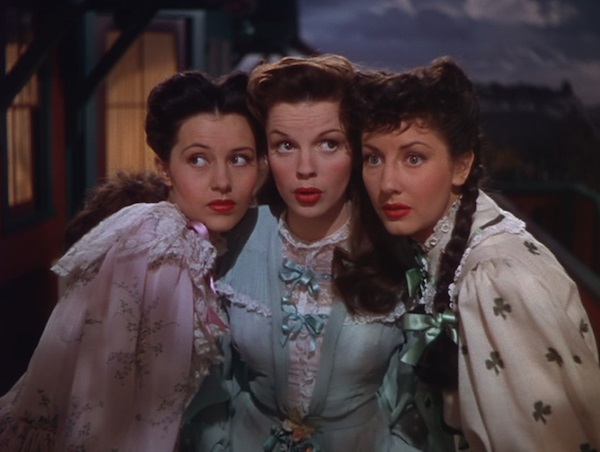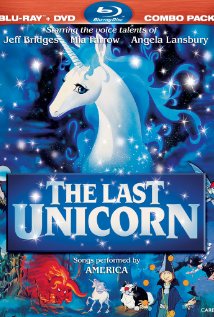This is a guest post written by Kristen Lopez.
If history and Hollywood have taught us anything it is that the West was conquered by courageous cowboys on horseback who beat the “savages” out of the hills in a bid for MAN-ifest Destiny. This point has been reiterated endlessly by American cinema who put manly men like John Wayne, Randolph Scott, and Errol Flynn in the saddle and told audiences women-folk were there for local color or nursing but, no matter what, were always kept out of site. In this brave new world women are simply passengers… or are they?
Best known for directing bubblegum teen fare like Bye Bye Birdie (1963) and Viva Las Vegas (1964), director George Sidney and a crew of at least six credited writers crafted a feminist look at the old West in 1946 with The Harvey Girls, a tale of women, both good and bad, that extends beyond trite definitions and turns into a poignant musical of female friendship, uncompromising personalities, and a world where men get in the way of progress.
Set in the 1890s, the “Harvey Girls” of the title are waitresses at a burgeoning restaurant chain popping up along the Atchison, Topeka and Santa Fe train route. The selected girls are all meant to espouse “clean living,” displaying a patch of innocence in the rambunctious West. Heading to the small town of Sandrock are a new crop of waitresses, and Susan Bradley (Judy Garland), a young woman who’s answered a “lonely hearts” ad and hopes to marry her unseen lover in town.
The film immediately presents us with a group of women setting out to create their own futures. The Harvey Girls themselves seek nothing more than a job and a means of seeing the world, many leaving towns where they were told their looks are their only worth and marriage is their end goal.
The town of Sandrock is presented as a stereotypical lawless society where the men control commerce, religion, and safety. Yet their control is little more than a façade for their licentiousness. The town hasn’t progressed short of creating a saloon, and the men in charge are seemingly content with a world of duels, gunfights, and general primitivism. It isn’t until the Harvey restaurant opens that a semblance of domesticity arrives.
However, the term domesticity isn’t derogatorily applied here. Because the women aren’t on the hunt for men, their presence brings with it progress; the local priest believes he can reopen the church, the saloon is shown for the money trap that it is, etc. Women are even presented in male centric jobs; Alma from Ohio (Virignia O’Brien) shows her flair at shoeing horses better than the man in the position, singing and dancing while doing it. Even the Harvey House, with its male identification in the title, is saved through Susan’s dominance — and six guns – as she gets back the restaurant’s stolen meat on opening day.
Ned Trent (John Hodiak), the local saloon owner, starts out as a mild-mannered villain, but becomes an ally to Susan and the women in the Harvey House. Even then, though, his role is limited to shooting snakes and flashing muscle. It is the women’s ingenuity and interest in his proffered help that brings him into the fold; Trent is a man controlled, not the ruler.
It is within the saloon that The Harvey Girls’ true feministic impulses present themselves. The clean-cut Harvey Girls, with Susan as their leader, are contrasted with the garish, sexualized saloon girls led by Em (Angela Lansbury). Though Em and Susan are both in love with Ned, it is only a surface issue since Em refuses to compromise her ideals to attract Ned. Instead, she simply reiterates to Susan that Ned doesn’t love her.
The male-centric audience are presented with the Madonna and the whore through Susan and Em, but the focal point is firmly on both women’s presentation of their desires, personalities, and dreams in life. Em understands the simplistic men in Sandrock see the Harvey Girls as clean and pure, but Em and her girls are never presented as immoral as the men in the town. The audience, and the men, are tame in their lust for Em and her ladies – and there’s no implication of prostitution outside of imagination – but it is evident Susan and the other Harvey ladies represent clean living. Short of their wardrobes – the loud, thigh revealing costumes of the saloon versus the floor-length, black and white dresses of the Harvey House – the audience is left to interpret and give Em and her ladies a darker past than they actually have.
This all comes to the fore in the film’s climax. Em and her ladies decide to blitz out for greener pastures, leaving Sandrock and its newly staid atmosphere to the Harvey House. The women aren’t run out on a rail, but it is obvious Em fancies herself bigger than the small confines of Sandrock and her financial livelihood is at stake with the conversion of the saloon. Em is still allowed to have her dreams and pursue them without a man by her side. In fact, it is Em who, despite the fights and pettiness between both women, tells Susan that Ned adores her (Susan).
This moment is a breakthrough, particularly for a film mired in post-WWII images of Rosie the Riveter. Em, a character who has done little good in the movie, is allowed to have a moment of support and friendship with a female rival, a rival for a man no less. Em doesn’t end the movie with a newfound change of heart or a renunciation of her wicked ways. In fact, we’re given a glimpse into Em’s personality that the town of Sandrock and its male dominated chauvinism, has forced Em to hide. Though Susan is the film’s heroine, it is Em who is the truly fascinating character within The Harvey Girls; a woman with aspirations and flaws who still succeeds on her own terms and isn’t condemned by others, but, in fact, helps those different from her (like Susan) find their way.
Em and all the women in The Harvey Girls are not dragged into marriage. Marriage is joked about — “I sent my picture into one of those Lonely Hearts Clubs and they sent it back, saying, ‘We’re not THAT lonely” — but never stated as awaiting them at the train station. If anything, the men of Sandrock anticipate the women’s arrival with their own matrimonial intentions.
Upon arrival, Susan meets her intended, H.H. Hartsey (Chill Wills), only to discover he’s an “old coot.” Where the marriage plot usually becomes the climax, here it is the catalyst for Susan’s self-discovery. H.H. is a decent man living in an immoral town and is unwilling to marry Susan despite her beauty because the two aren’t compatible. Hartsey is the stereotypical cowboy, grizzled with an “aw, shucks” attitude shown for what it is, sweet but unattractive. We’re presented with the non-John Wayne version of the cowboy. The cowboys that existed, but weren’t Hollywood leading men. Though both characters are polite, it’s evident Sandrock isn’t interested in being a fantasy town, and both characters realize they’re unsuited for each other.
Coupled with the women’s seeming disinterest in it, marriage in The Harvey Girls is never brought up again within this context. Characters fall in love, but it’s never stated they’ll put a ring on it or that they’ll stay together past the end credits, though it is heavily implied due to its Hollywood tone. Marriage is presented as an open door, allowing Susan to become a Harvey Girl and gain her independence.
In a world commonly presented as male dominated, The Harvey Girls gives us a portrait of the Old West corralled by women; where women aren’t roped into marriage, take on male-centric jobs, run restaurants, and become friendly with their enemies. Though the 1940s Hollywood veneer of breeziness remains, The Harvey Girls uses its flippant presentation to give a deeply feminist examination of how women worked and struggled to carve out a piece of the West on their own terms.
Kristen Lopez is a freelance writer whose work has appeared on Film School Rejects, The Playlist, Awards Circuit, and Cinema Sentries. She is currently the Associate Editor at ClassicFlix and the owner of the classic film site, Journeys in Classic Film.












